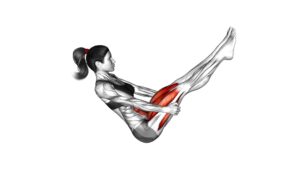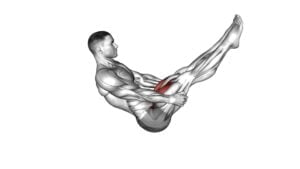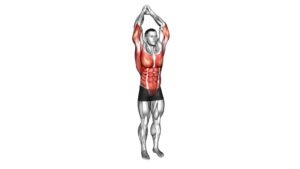Half Boat Pose Ardha Navasana (female) – Video Exercise Guide & Tips

Get ready to strengthen your core and improve your balance with Half Boat Pose, also known as Ardha Navasana.
Watch This Exercise Video
In this video exercise guide, we'll walk you through the step-by-step instructions for this pose, highlighting common mistakes to avoid and offering modifications and variations.
Whether you're a beginner or more advanced, these tips will help you enhance your stability and achieve proper form.
So grab your mat and let's dive into Half Boat Pose!
Key Takeaways
- Half Boat Pose Ardha Navasana strengthens and tones abdominal muscles.
- It supports the growing belly during pregnancy and alleviates lower back pain in pregnant women.
- The pose improves digestion and stimulates abdominal organs.
- It enhances balance, stability, posture, and spinal alignment.
Benefits of Half Boat Pose for Females
To understand the benefits of Half Boat Pose for females, you should know that it can help strengthen and tone the abdominal muscles. This is particularly beneficial for pregnant women, as it can help support the growing belly and alleviate lower back pain. Half Boat Pose also improves digestion and stimulates the organs in the abdomen, which can be helpful during pregnancy when digestion can be sluggish. Additionally, practicing this pose can improve balance and stability, which is important for pregnant women as their center of gravity shifts.
For beginners, modifying Half Boat Pose can make it more accessible. Start by sitting on a folded blanket or block to elevate the hips and make it easier to balance. You can also bend your knees and place your feet flat on the ground, keeping the hands behind the thighs for support. Gradually, as you build strength and stability, you can straighten the legs and lift the feet off the ground, finding the full expression of the pose.
Remember to listen to your body and never push yourself beyond your limits. If you experience any discomfort or pain, modify the pose or consult with a qualified yoga instructor. With consistent practice and proper modifications, Half Boat Pose can be a beneficial and empowering pose for females of all levels.
Step-by-Step Instructions for Half Boat Pose
Follow these step-by-step instructions for Half Boat Pose to strengthen and tone your abdominal muscles. Half Boat Pose, also known as Ardha Navasana, is a challenging yoga pose that offers numerous benefits for both males and females. While the previous subtopic discussed the benefits of this pose for females, it's important to note that males can also reap the rewards of practicing Half Boat Pose.
To begin, sit on the floor with your legs extended in front of you. Place your hands on the mat next to your hips for support. Gently lean back, engaging your core muscles. Slowly lift your feet off the ground, bringing your shins parallel to the floor. Keep your knees bent at a 90-degree angle.
As you become more comfortable in this pose, you can deepen the stretch by straightening your legs. Lengthen your spine and lift your chest towards the ceiling. Keep your gaze forward and hold the pose for several breaths.
To further intensify the stretch, you can try extending your arms forward, parallel to the floor. Maintain a steady breath and focus on engaging your abdominal muscles throughout the pose.
Practicing Half Boat Pose regularly can help strengthen your core, improve your posture, and increase your overall body awareness. Remember to listen to your body and modify the pose as needed.
Enjoy the benefits of this pose and feel your abdominal muscles getting stronger with each practice.
Common Mistakes to Avoid in Half Boat Pose
Avoid these common mistakes when practicing Half Boat Pose to ensure proper alignment and maximize the benefits of the pose.
One common mistake is rounding your back. Instead, focus on keeping a straight spine throughout the pose. This will engage your core muscles and provide a deeper stretch.
Another mistake to avoid is collapsing your chest and shoulders. Keep your chest lifted and your shoulders relaxed, allowing your upper body to stay open and engaged.
Additionally, be mindful of your neck and avoid straining it by looking down or tucking your chin. Instead, gaze forward or slightly upward to maintain a neutral neck position.
It's also important to avoid gripping your toes or the sides of your mat. This can create tension in your hip flexors and prevent you from fully engaging your core. Instead, keep your hands by your sides or lightly rest them on your thighs.
Lastly, avoid locking your knees. Keep a slight bend in your knees to protect your joints and maintain stability.
Modifications and Variations for Half Boat Pose
Try out different modifications and variations to enhance your Half Boat Pose practice and cater to your individual needs and abilities.
If you find it challenging to balance in the traditional seated position, you can try standing modifications of Half Boat Pose. To do this, stand with your feet hip-width apart and extend your arms in front of you. Lift one leg off the ground, keeping it straight, while simultaneously lowering your upper body towards the lifted leg. Engage your core to maintain balance and hold this position for a few breaths before switching sides.
Another option is to incorporate chair variations of Half Boat Pose. Sit on the edge of a chair with your feet flat on the ground. Lean back slightly, engage your core, and lift one leg off the ground while straightening it. Hold this position for a few breaths before switching sides.
Remember to listen to your body and only go as far as feels comfortable. These modifications and variations allow you to adapt the pose to your current abilities and gradually work towards the full expression of Half Boat Pose.
Tips for Improving Balance and Stability in Half Boat Pose
To improve your balance and stability in Half Boat Pose, focus on engaging your core muscles throughout the pose. This will help you maintain proper alignment and prevent any wobbling or tipping over.
Here are some tips to help you enhance your balance and stability in Half Boat Pose:
- Ground your sit bones: Sit tall and firmly on the mat, making sure your sit bones are rooted into the ground. This will provide a stable foundation for the pose.
- Lengthen your spine: Imagine a string pulling the crown of your head towards the ceiling, lengthening your spine. This will help you maintain a straight and balanced posture.
- Use your breath: Take deep breaths and focus on your breath throughout the pose. This will help you stay centered and calm, enhancing your stability.
- Modify the intensity: If you find the pose challenging, you can modify it by bending your knees or placing your hands behind your thighs for support. This will allow you to gradually build your balance and stability.
- Engage your core: Actively engage your core muscles by drawing your navel towards your spine. This will provide additional support and stability to your body.
Frequently Asked Questions
How Long Should I Hold the Half Boat Pose to Get Maximum Benefits?
To get maximum benefits from the half boat pose, hold it for at least 30 seconds to a minute. This will engage your core muscles and build strength.
Beginners can modify the pose by keeping their knees bent and placing their hands behind their thighs for support.
Advanced practitioners can try variations like straightening their legs or reaching their arms forward.
Remember to listen to your body and adjust as needed.
Can Half Boat Pose Help in Reducing Belly Fat?
Half Boat Pose is a great exercise for strengthening your core muscles. It can also be effective in reducing belly fat when combined with a healthy diet and regular cardiovascular exercise.
To challenge yourself further, you can try different variations of the pose, such as extending your arms overhead or lifting your legs higher.
Remember to engage your core and breathe deeply throughout the exercise for maximum benefits.
Is Half Boat Pose Safe During Pregnancy?
During pregnancy, it's important to modify half boat pose to ensure safety and comfort. Avoid lying flat on your back and instead prop yourself up with blankets or bolsters. This will alleviate pressure on your abdomen.
Practicing half boat pose can help strengthen your core and pelvic floor muscles, which can be beneficial during labor and postpartum recovery.
Remember to listen to your body and consult with your healthcare provider before starting any exercise routine.
Can Half Boat Pose Be Practiced by Beginners?
Yes, half boat pose can be practiced by beginners. It's a great pose to strengthen your core muscles. To make it easier, you can modify the pose by keeping your feet on the ground and placing your hands behind your thighs for support.
As you build strength, you can gradually lift your feet off the ground. Half boat pose is a wonderful exercise that will help you develop a stronger core and improve your overall stability.
Are There Any Specific Breathing Techniques to Follow While Performing Half Boat Pose?
When practicing half boat pose, it's important to pay attention to your breath.
There are specific breathing techniques that can enhance your experience in this pose. As you lift your chest and legs, inhale deeply through your nose. As you lower them back down, exhale through your mouth. This rhythmic breathing will help you maintain balance and focus.
Conclusion
In conclusion, practicing Half Boat Pose can offer numerous benefits for females. It helps strengthen the core, back, and hip muscles, improves digestion, and enhances balance and stability.
By following the step-by-step instructions and avoiding common mistakes, you can ensure proper alignment and maximize the pose's effectiveness. Additionally, modifications and variations can be incorporated to suit individual needs and abilities.
With practice and focus, you can improve your balance and stability in Half Boat Pose.

Author
Years ago, the spark of my life’s passion ignited in my mind the moment I stepped into the local gym for the first time. The inaugural bead of perspiration, the initial endeavor, the very first surge of endorphins, and a sense of pride that washed over me post-workout marked the beginning of my deep-seated interest in strength sports, fitness, and sports nutrition. This very curiosity blossomed rapidly into a profound fascination, propelling me to earn a Master’s degree in Physical Education from the Academy of Physical Education in Krakow, followed by a Sports Manager diploma from the Jagiellonian University. My journey of growth led me to gain more specialized qualifications, such as being a certified personal trainer with a focus on sports dietetics, a lifeguard, and an instructor for wellness and corrective gymnastics. Theoretical knowledge paired seamlessly with practical experience, reinforcing my belief that the transformation of individuals under my guidance was also a reflection of my personal growth. This belief holds true even today. Each day, I strive to push the boundaries and explore new realms. These realms gently elevate me to greater heights. The unique combination of passion for my field and the continuous quest for growth fuels my drive to break new ground.







